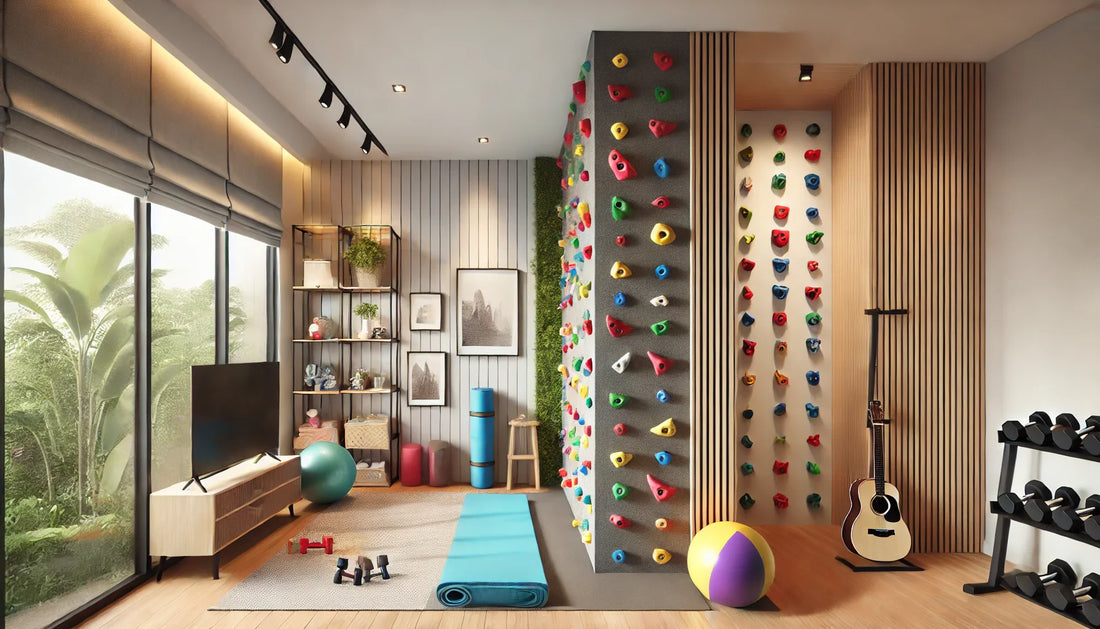Introduction
Creating a climbing wall in a multi-purpose room is the ultimate way to blend fitness, fun, and functionality in your home. Whether it’s a shared space like a living room, garage, or playroom, a well-planned climbing wall can fit seamlessly into your lifestyle. Here’s how to design a versatile setup that works for everyone in the household.
1. Define the Room’s Functions
Before designing your climbing wall, consider how the room will be used:
- Fitness and Training: A space for both climbing and general workouts.
- Family Playroom: A kid-friendly area for active play and creativity.
- Office and Fitness Combo: A workspace that doubles as a fitness zone for quick breaks.
Understanding the primary purpose will help guide your wall’s design and placement.
2. Choose a Compact or Modular Wall Design
In a multi-purpose room, space is often limited, so efficient design is key:
- Compact Walls: Opt for a vertical or slightly overhanging wall to save space.
- Modular Walls: Build a freestanding or removable wall that can be adjusted or relocated as needed.
Follow these modular wall design instructions to create a setup that adapts to your space.
3. Prioritize Safety and Accessibility
In a shared space, safety is non-negotiable:
- Crash Mats: Use high-quality mats to cushion falls and protect the floor.
- Hold Placement: Position holds to accommodate climbers of all ages and skill levels.
- Clearance: Ensure there’s enough space around the wall for safe climbing and falling.
4. Blend the Wall with the Room’s Aesthetics
A climbing wall doesn’t have to dominate the room—it can enhance its style:
- Painted Designs: Use bright, playful colors for a kids’ space or neutral tones for a sleek gym vibe.
- Themed Walls: Match the wall’s design to the room’s purpose, like a jungle theme for a playroom or a minimalist look for a workout area.
- Storage Solutions: Include hooks, shelves, or hidden compartments for gear storage to keep the room tidy.
5. Add Multi-Use Features
To maximize functionality, incorporate extra features into your wall:
- Hangboards or Pull-Up Bars: Combine climbing training with other fitness tools.
- Interactive Elements: Add chalkboards, magnetic holds, or LED lights for a creative twist.
- Expandable Routes: Use holds from climbing hold packages to switch up routes and challenges.
6. Make It Family-Friendly
If kids will use the space, include features tailored to them:
- Low-Level Routes: Add a section with easier holds and routes for young climbers.
- Climbing Games: Create interactive challenges like timed climbs or scavenger hunts.
- Safe Materials: Use smooth, non-toxic paint and rounded edges to prevent injuries.
7. Test and Adjust for Comfort
After installation, test your wall to ensure it fits seamlessly into the room’s flow:
- Make sure the wall doesn’t obstruct movement or furniture.
- Adjust routes and features as needed for ease of use.
- Incorporate feedback from other family members to fine-tune the setup.
Conclusion
A climbing wall can transform any multi-purpose room into an exciting and functional space. With smart design choices, safety considerations, and a focus on versatility, your wall will become the highlight of your home. Get started today with climbing hold packages and modular wall design instructions to create a wall that works for everyone!

